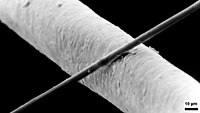
Photo from wikipedia
Patients with bone defects suffer from a high rate of disability and deformity. Poor contact of grafts with defective bones and insufficient osteogenic activities lead to increased loose risks and… Click to show full abstract
Patients with bone defects suffer from a high rate of disability and deformity. Poor contact of grafts with defective bones and insufficient osteogenic activities lead to increased loose risks and unsatisfied repair efficacy. Although self-expanding scaffolds were developed to enhance bone integration, the limitations on the high transition temperature and the unsatisfied bioactivity hindered greatly their clinical application. Herein, we report a near-infrared-responsive and tight-contacting scaffold that comprises of shape memory polyurethane (SMPU) as the thermal-responsive matrix and magnesium (Mg) as the photothermal and bioactive component, which fabricated by the low temperature rapid prototyping (LT-RP) 3D printing technology. As designed, due to synergistic effects of the components and the fabrication approach, the composite scaffold possesses a homogeneously porous structure, significantly improved mechanical properties and stable photothermal effects. The programmed scaffold can be heated to recover under near infrared irradiation in 60s. With 4 wt% Mg, the scaffold has the balanced shape fixity ratio of 93.6% and shape recovery ratio of 95.4%. The compressed composite scaffold could lift a 100 g weight under NIR light, which was more than 1700 times of its own weight. The results of the push-out tests and the finite element analysis (FEA) confirmed the tight-contacting ability of the SMPU/4 wt%Mg scaffold, which had a signficant enhancement compared to the scaffold without shape memory effects. Furthermore, The osteopromotive function of the scaffold has been demonstrated through a series of in vitro and in vivo studies. We envision this scaffold can be a clinically effective strategy for robust bone regeneration.
Journal Title: Bioactive Materials
Year Published: 2022
Link to full text (if available)
Share on Social Media: Sign Up to like & get
recommendations!